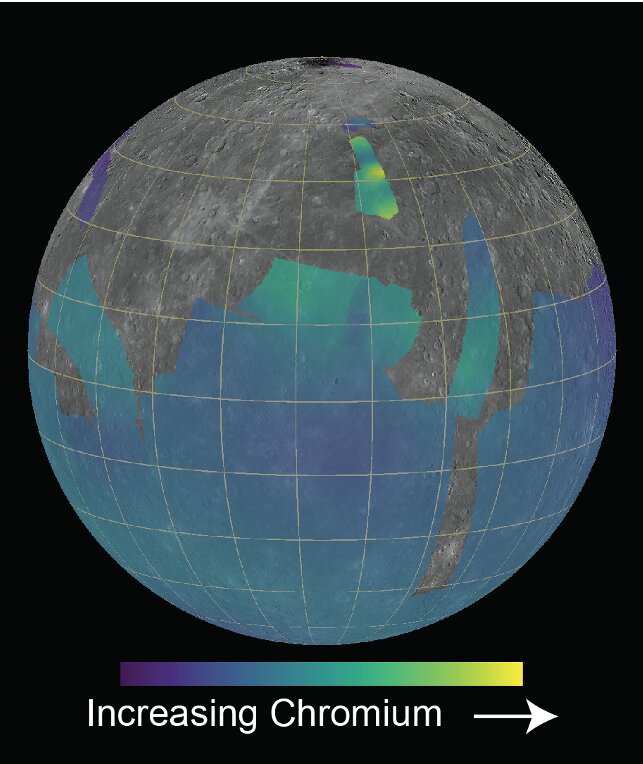The enigma of Mercury, the celestial body closest to the sun, continues to fascinate scientists. Despite sharing similarities with Earth, such as having a metallic core, Mercury’s core occupies a significantly larger portion of its volume – 85% compared to Earth’s 15%.
The MESSENGER (Mercury Surface, Space Environment, Geochemistry and Ranging) mission, a groundbreaking NASA Discovery-class endeavor that orbited Mercury, generated data revealing significant chemical disparities between Mercury and Earth. Notably, Mercury exhibits lower oxygen levels, suggesting its formation involved distinct building blocks during the early stages of the solar system. However, the precise determination of Mercury’s oxidation state based on available data has remained challenging.
In a newly published study led by Larry Nittler, a researcher from Arizona State University’s School of Earth and Space Exploration, data collected during the MESSENGER mission were utilized to assess and map the distribution of the minor element chromium across Mercury’s surface.
Chromium is renowned for its lustrous and corrosion-resistant properties, as well as its contribution to the vivid colors of gemstones like rubies and emeralds. Moreover, chromium can exist in various chemical states, offering valuable insights into the chemical conditions during its incorporation into rocks.
Nittler and his colleagues discovered that chromium abundance on Mercury varies by a factor of approximately four across its surface. By creating theoretical models that estimated the expected presence of chromium on Mercury’s surface during its differentiation into a crust, mantle, and core under various conditions, the researchers compared these models with the measured chromium abundance. Consequently, they concluded that Mercury’s large metallic core contains chromium and were able to establish new constraints on the planet’s overall oxidation state.
This groundbreaking research is featured in the July issue of the Journal of Geophysical Research: Planets.
“This is the first time that chromium has been directly detected and mapped across any planetary surface,” said Nittler. “By combining our data with advanced modeling techniques, we can gain unique insights into the origin and geological history of Mercury as chromium’s preferred state, be it oxide, sulfide, or metal mineral, depends on the amount of available oxygen.”
Co-author Asmaa Boujibar from Western Washington University, who conducted the modeling analysis presented in the study, added, “Our laboratory-based model confirms that the majority of chromium on Mercury is concentrated within its core. Given Mercury’s distinctive composition and formation conditions, we cannot directly compare its surface composition with that of terrestrial rocks. Therefore, it is crucial to conduct experiments simulating the specific oxygen-deficient environment in which the planet formed, separating it from Earth or Mars.”
In their study, Nittler, Boujibar, and their co-authors collated data from laboratory experiments and examined the behavior of chromium under varying oxygen levels in the system. They subsequently developed a model to investigate the distribution of chromium across Mercury’s different layers.
The findings definitively indicate that a substantial portion of chromium, akin to iron, is indeed situated within Mercury’s core. The researchers also observed that as the planet becomes increasingly oxygen-deficient, a greater quantity of chromium becomes concealed within its interior. This knowledge significantly enhances our comprehension of the elemental composition and geological processes at work within Mercury.
More information:
Larry R. Nittler et al, Chromium on Mercury: New Results From the MESSENGER X‐Ray Spectrometer and Implications for the Innermost Planet’s Geochemical Evolution, Journal of Geophysical Research: Planets (2023). DOI: 10.1029/2022JE007691
Citation:
Scientists use NASA MESSENGER mission data to measure chromium on Mercury (2023, July 10)
retrieved 11 July 2023
from https://phys.org/news/2023-07-scientists-nasa-messenger-mission-chromium.html
This document is subject to copyright. Apart from any fair dealing for the purpose of private study or research, no
part may be reproduced without the written permission. The content is provided for information purposes only.
Denial of responsibility! TechCodex is an automatic aggregator of the all world’s media. In each content, the hyperlink to the primary source is specified. All trademarks belong to their rightful owners, and all materials to their authors. For any complaint, please reach us at – [email protected]. We will take necessary action within 24 hours.

Jessica Irvine is a tech enthusiast specializing in gadgets. From smart home devices to cutting-edge electronics, Jessica explores the world of consumer tech, offering readers comprehensive reviews, hands-on experiences, and expert insights into the coolest and most innovative gadgets on the market.


